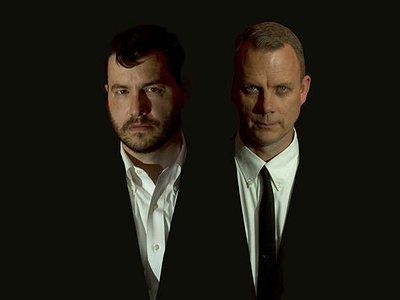Fear of commitment
Matmos is the evil slime that features in the kitsch 60s franchise Barbarella, but it's also the moniker of ambient electro duo Drew Daniels and MC Schmidt. The duo are known for taking unusual found sounds, which can include anything from liposuction to the sound of a frozen stream thawing in the sun and turning them into surprisingly accessible formats. They've produced music as mainstream as pop but as diverse as soundtracks and performance art with a luminous circle of collaborators including Bjork, Antony and J Lesser and artists like Daria Martin, Young Jean Lee and Marina Abramovic. With Daniels occupying the abstract and Schmidt preferring to inhabit the physical realm, together the couple create music that challenges and entertains. Whether it's virtual, real or implied, Matmos invites the listener to discover and understand the context, the subject and the process of the music.
When did you start writing/producing music - and what or who were your early passions and influences?
My starting point wasn’t music but sound- I started making cut-ups with tape recorders when I was fifteen, editing funny little skit-like things out of records and the radio with a pause button. I did it because I had read about William S. Burroughs’ experiments with tape recorders and cut-ups and wanted to try that out myself. So I acquired a lot of cheap little plastic tape recorders and began to make pause-button edits, and then started doing primitive multi-tracking of noises and voices by having four tapes play in a room and recording them all to a fifth tape deck. I loved, in order, disco, heavy metal, hip hop, new wave, punk and hardcore and then industrial and noise. That’s the cycle from age 11 to age 16.
What do you personally consider to be the incisive moments in your artistic work and/or career?
The most literally incisive moments were the recordings of cosmetic surgery that generated our album A Chance to Cut Is A Chance to Cure: rhinoplasty, chin implants, liposuction.
I think meeting Martin was the catalyst for it all. We made a tape called Matmos in Lo Fidelity that was entirely in 8 bit. It was just an exercise in cutting and editing sound intensively, with lots of hyper juxtapositions and ridiculous noises - that was so fun to make, and was the beginning our romantic and musical partnership.
What are currently your main compositional- and production-challenges?
It is always the same challenge- to listen to each other, to be honest about what we’re hearing, to share the studio and the space of the composition, to avoid repeating stale gestures, to avoid desperate attempts to fit into the current landscape of what is popular, to press ourselves to have a stance of militant fidelity towards our own agenda, to not collapse into petty bickering about trivial things.
What do you usually start with when working on a new piece?
I tend to start with a conceptual orientation and Martin tends to start with an object or an instrument. So I start with a commitment to a particular idea (telepathy, medical technology, queer biography) and Martin tends to start with something hands on.
How strictly do you separate improvising and composing?
We just played an improv set last week in Baltimore that was really fun. Martin “practices” by simply sitting with his gear and exploring in a relatively free-form way, and I prepare by grabbing tons of sounds from a wide variety of sources including things like springs, a phone, a wooden box, a studded punk rock jacket, metal rods; and sound sources that could be a huge old box of cassettes from the 90s and grabbing hundreds of two second snippets. But in the moment, there’s no commitment to a form or a genre. Something might become rhythmic, or not, might become tonally centred or drone-like or not, it might be about speech or not, might fall into a form or not. “Composing” just means putting things together in some kind of order. Improvisation is composition in real time, and we often harvest from that for our “real songs”, so I see the two things as feeding forward into each other in an endless recursive loop.
How do you see the relationship between sound, space and composition?
It’s something you have to keep flexible as a part of your practice. Electronic tools allow you to capture a real space (mics, field recording) and allow you to synthesise virtual spaces (virtual spaces of reverbs and, more recently, physical modelling software, which I use frequently). Then there’s the kind of implied space of music which you produce- is this for the bedroom? Car? Living room? Headphone space? Then there’s the question of how, in live performance, you either work with the space that you are actually in or try to turn it against its normal use or function.
A “big” sound in a little room can be nicely jarring or it can be arrogant and pretentious- it depends on how you present it. I prefer close microphoned recordings and I don’t like the suggestion of cavernous, huge spaces much. There are people who are great at doing that but it’s not really us. We like to get up close to things.
Do you feel it important that an audience is able to deduct the processes and ideas behind a work purely on the basis of the music? If so, how do you make them transparent?
If I put on my pretentious academic hat, I would say that Matmos make assemblages- that is, we make gatherings of sounds and patterns at the sonic level, and we make constructions of signs and signifiers and information at the level of discourse, and our work consists of either an additive pair of song + information, or, ideally, a multiplicative pair of song x information, in which knowing that the song is made out of plastic surgery noises acts upon the sounds you hear and changes them, if you give a shit enough to read the liner notes and figure out the sound source. But it’s totally fine if you don’t, and just listen to it as music and experience it on an immanent sonic level.
Our goal is that the process offers a way into the sound, and lets you experience it more deeply, but that information is optional. There’s always going to be a gap between your intentions and the work’s effects on its own term, and you have to accept that. We are very much control freaks about the components that enter our music and the way that information gets attached to it, but we can’t legislate how much attention the listener brings, and that’s a good thing- it opens out the work so that it can circulate in more and less demanding ways. Also: “knowing” and “caring” are different stances and sometimes the former gets in the way of the latter.
In how much, do you feel, are creative decisions shaped by cultural differences – and in how much, vice versa, is the perception of sound influenced by cultural differences?
This is so general that I don’t think I can really say something that wouldn’t be speculative bullshit. I would be interested to know if the experiments of cultural anthropologists into the weirdly similar organisation of colour experience across different cultures does or does not have a similar outcome for the recognition or enjoyment of sound. Generalising, I’d say that vibrations only become „sounds“ as a result of cultural habits of filtering raw information into something that we isolate through naming, indicating and noticing. There’s an ontology of vibration that precedes culture, and even precedes living systems that are equipped to hear things.
The relationship between music and other forms of art – painting, video art and cinema most importantly - has become increasingly important. How do you see this relationship yourself and in how far, do you feel, does music relate to other senses than hearing alone?
Recent research suggests that our visual experience is closely related to the movement of the body- seeing and being in a positioned living system in which moves are structurally wired together. I wonder if it’s the same for sound? Sound offers a way of being oriented in a world which is never simply sonic, unless you are a brain in a vat and only your auditory nerves are functional. It’s weird to think about what sound without vision would make available and what it would conceal, hard to imagine really. I would have to talk to blind people about this to get an independent view, but even then, sound and touch might be looping into each other in various ways, either through association or through a larger system of “how to imagine distance and proximity” in consciousness. So, yeah, sound is not an isolated pathway of perception but part of a bigger manifold and it gets experienced in tandem with other senses.
I feel like sound is kind of an underdog, honestly- we’re in a visual culture and the eye tends to trump the ear for lots of reasons that might be both cultural and biological, or both via some kind of interactionism.
When you watch performance, you’re listening for sounds and looking at gestures and electronics crucially sunders the connection between a physical cause and a sonic outcome- that’s the acousmatic dimension that French musique concrete composers and theorists got so excited about exploring.
When we perform we like to have a “band/and” approach of video and sound, and of video which sometimes documents real-time sound-making and sometimes doesn’t. We give people enough visually, to see that we’re doing something live, but we don’t exhaustively demonstrate how that works, because then it becomes like a trade show or a cooking show and the content disappears beneath the weight of the process.






